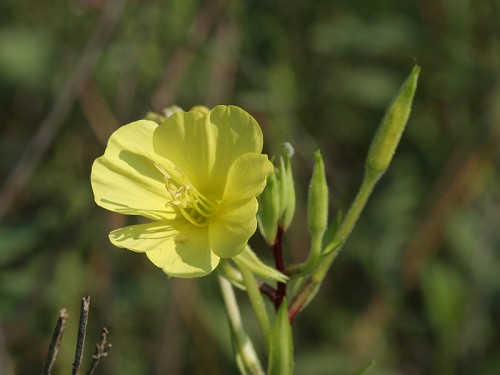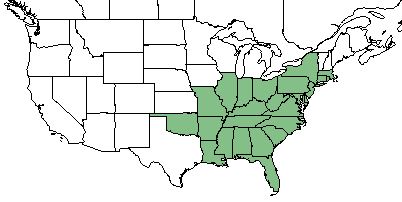Difference between revisions of "Oenothera fruticosa"
(→Cultural use) |
|||
| Line 33: | Line 33: | ||
==Ecology== | ==Ecology== | ||
| − | ===Habitat=== <!--Natural communities, human disturbed habitats, topography, hydrology, soils, light, fire regime requirements for removal of competition, etc.--> | + | ===Habitat=== <!--Natural communities, human disturbed habitats, topography, hydrology, soils, light, fire regime requirements for removal of competition, etc.--><!--var. ''microcarpa'' frequents boggy depressions; var. ''subglobosa'', though rare, is found on granite flatrocks and domes; and var. unguiculata grows in sandhills and moist to wet loamy savannas.--> |
| − | + | ||
| + | ''O. fruticosa'' has been found in dry forests and woodlands, glades, shaded river banks, swampy floodplains, pine flatwoods, oak-hickory-sweetgum woodlands, and rock outcrops.<ref name="weakley">Weakley, A.S. 2015. Flora of the southern and mid-atlantic states. Working Draft of 21 May 2015. University of North Carolina at Chapel Hill, Chapel Hill, North Carolina.</ref><ref name="FSU"/> It is also found in disturbed areas including burned upland pinelands and roadsides.<ref name="FSU"> Florida State University Herbarium Database. URL: http://herbarium.bio.fsu.edu. Last accessed: June 2021. Collectors: Loran C. Anderson and Andre F. Clewell. States and counties: Florida: Franklin, Leon, and Wakulla.</ref> Associated species: ''Pyrrhopappus carolinianus, Oenothera laciniata'', and ''Valerianella radiata''.<ref name="FSU"/> | ||
===Phenology=== <!--Timing off flowering, fruiting, seed dispersal, and environmental triggers. Cite PanFlora website if appropriate: http://www.gilnelson.com/PanFlora/ --> | ===Phenology=== <!--Timing off flowering, fruiting, seed dispersal, and environmental triggers. Cite PanFlora website if appropriate: http://www.gilnelson.com/PanFlora/ --> | ||
Revision as of 17:15, 14 June 2021
| Oenothera fruticosa | |
|---|---|

| |
| Photo by John Gwaltney at Southeastern Flora.com | |
| Scientific classification | |
| Kingdom: | Plantae |
| Division: | Magnoliophyta - Flowering plants |
| Class: | Magnoliopsida - Dicots |
| Order: | Myrtales |
| Family: | Onagraceae |
| Genus: | Oenothera |
| Species: | O. fruticosa |
| Binomial name | |
| Oenothera fruticosa L. | |

| |
| Natural range of Oenothera fruticosa from USDA NRCS Plants Database. | |
Common Name(s): Southern sundrops, Small-fruited sundrops, Flatrock sundrops[1]
Contents
Taxonomic Notes
Synonyms: Gaura filipes var. filipes; G. filipes var. major Torrey & A. Gray; Gaura michauxi Spach; Kneiffia arenicola Small; K. fruticosa (Linnaeus) Raimann; K. semiglandulosa Pennell; K. subglobosa Small.[1]
Varieties: Oenothera fruticosa Linnaeus var. fruticosa; Oenothera fruticosa Linnaeus var. microcarpa Fernald; Oenothera fruticosa Linnaeus var. subglobosa (Small) Munz; Oenothera fruticosa Linnaeus var. unguiculata Fernald.[1]
Description
Oenothera fruticosa is a dioecious perennial forb/herb[2] that reaches 18-24 in (0.46-0.61 m) in height.[3] It can be found as a diffusely clustered system of unbranched stems containing lance-shaped leaves of 2-3 in (5.1-7.6 cm) in length. During the winter months in its southern range, O. fruticosa appears as a reddish-purple basal rosette. This species requires sunlight and well-drained soils but is also tolerant of brackish and lime soils.[3]
Var. unguiculata can be distinguished by their sepal tips that are 1-3 mm long, cartilaginous, and often arching after the sepals have reflexed, as ell as a strigose calyx. The other varieties should have sepal tips that are less than 1 mm long. The other varieties can be distinguished by their capsule body lengths and pubescence: var. fruticosa has a 6-ll mm long capsule body with coarse pubescence; var. microcarpa has a 3.5-4 mm long capsule body that is strigose-pilose; var. subglobosa has a 4-5 mm long capsule body that is very finely strigillose.[1]
Distribution
O. fruticosa can be found in from Maine south to Florida and westward to Michigan, Missouri, Oklahoma, and Louisiana.[2][1] It can also be found in parts of Manitoba, Ontario, and Quebec provinces in Canada.[2] Var. fruticosa ranges from Massachusetts to Indiana and south to Florida and Louisiana. Var. microcarpa ranges from eastern Maryland to eastern South Carolina. Var. subglobosa is restricted to the south, ranging from Georgia to Alabama. Finally, var. unguiculata has a more southeastern range, extending from southeastern Virginia to eastern South Carolina.[1]
Ecology
Habitat
O. fruticosa has been found in dry forests and woodlands, glades, shaded river banks, swampy floodplains, pine flatwoods, oak-hickory-sweetgum woodlands, and rock outcrops.[1][4] It is also found in disturbed areas including burned upland pinelands and roadsides.[4] Associated species: Pyrrhopappus carolinianus, Oenothera laciniata, and Valerianella radiata.[4]
Phenology
O. fruticosa has been observed flowering from May through August,[1][5] peaking in April and May.[5] It produces four-petaled golden yellow flowers that average 2 in (5.1 cm) in diameter.[3]Early in the growing season, basal rosettes of leaves are produced that sometimes have random burgundy spots.[6]
Seed dispersal
This species is thought to be dispersed by gravity.[7]
Seed bank and germination
In Illinois farmed and unfarmed bald cypress swamps, seeds of O. fruticosa averaged densities of 99 and 166 seeds m-2, respectively.[8] O. fruticosa requires at least 3 weeks of vernalization (cooling of seeds during germination) to reduce the time to flowering and produce a high percentage of flowering. Plant height would peak at 40-50 cm (15.7-19.7 in) after 9 weeks of vernalization and a 14-hour photoperiod. Increasing photoperiods from 10-16 hours also caused decreases in the time until flowering, the number of new nodes, the number of flowers, and the number of lateral shoots. Temperatures from 15-30 °C (59-86 °F) were indirectly proportional to the number of flowers, flower diameter, and plant height.[9]
Pollination
It is known to attract birds, hummingbirds, and a large number of native bees.[3] Honeybees deposit, on average, 193-223 grains of pollen per visit to O. fruticosa.[10][11] Soldier beetles also pollinate O. fruticosa, leaving 114 grains of pollen per visit.[11] The number of seeds set is proportional to the number of pollen grains which asymptotes around 150 seeds set and 400 pollen grains.[10]
Use by animals
Oenothera fruticosa composes 2-5% of the diet of large mammals and 5-10% of the diet for terrestrial birds.[2]
Conservation, cultivation, and restoration
Cultural use
Evening-Primroses can be used as a potherb for their asparagus-like quality of greens, and Native Americans would use the pith to make soup. In England, there was a problem of using the leaves as a tea filler.[12]
Photo Gallery
References and notes
- ↑ 1.0 1.1 1.2 1.3 1.4 1.5 1.6 1.7 Weakley, A.S. 2015. Flora of the southern and mid-atlantic states. Working Draft of 21 May 2015. University of North Carolina at Chapel Hill, Chapel Hill, North Carolina.
- ↑ 2.0 2.1 2.2 2.3 USDA, NRCS. (2016). The PLANTS Database (http://plants.usda.gov, 30 May 2019). National Plant Data Team, Greensboro, NC 27401-4901 USA.
- ↑ 3.0 3.1 3.2 3.3 [[1]] Ladybird Johnson Wildflower Center. Accessed: January 8, 2016
- ↑ 4.0 4.1 4.2 Florida State University Herbarium Database. URL: http://herbarium.bio.fsu.edu. Last accessed: June 2021. Collectors: Loran C. Anderson and Andre F. Clewell. States and counties: Florida: Franklin, Leon, and Wakulla.
- ↑ 5.0 5.1 Nelson, G. PanFlora: Plant data for the eastern United States with emphasis on the Southeastern Coastal Plains, Florida, and the Florida Panhandle. www.gilnelson.com/PanFlora/ Accessed: 20 DEC 2017
- ↑ Osorio R. 1994 Sundrops and Friends Palmetto 14(2):9
- ↑ Kirkman, L. Katherine. Unpublished database of seed dispersal mode of plants found in Coastal Plain longleaf pine-grasslands of the Jones Ecological Research Center, Georgia.
- ↑ Middleton B. A. (2003). Soil seed banks and the potential restoration of forested wetlands after farming. Journal of Applied Ecology 40:1025-1034.
- ↑ Clough E. A., Cameron A. C., Heins R. D., and Carlson W. H. (2001). Growth and development of Oenothera fruticosa is influenced by vernalization duration, photoperiod, forcing temperature, and plant growth regulators. Journal of the American Society of Horticulture Science 126(3):269-274.
- ↑ 10.0 10.1 Silander J. A. and Primack R. B. (1978). Pollination intensity and seed set in the evening primrose (Oenothera fruticose). The American Midland Naturalist 100(1):213-216.
- ↑ 11.0 11.1 Primack R. B. and Silander, Jr. J. A. (1975). Measuring the relative importance of different pollinators to plants. Nature 255(5504):143-144.
- ↑ Fernald, et al. 1958. Edible Plants of Eastern North America. Harper and Row Publishers, New York.